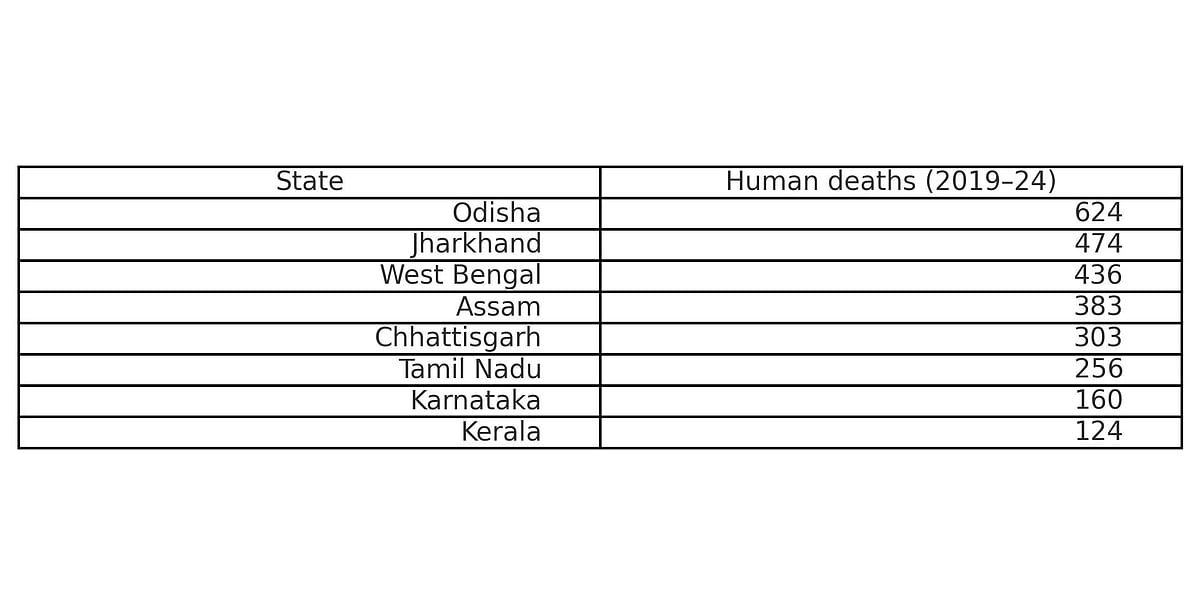Farmer trampled in Andhra, spike in human–elephant conflict across India
Both government and independent data show thousands of human deaths linked to elephant encounters over multi-year periods

A 65-year-old farmer was trampled to death by a wild elephant in the early hours of Thursday in Kurmanupalli village of Chittoor district in Andhra Pradesh, underscoring a wider surge in fatal encounters between humans and wildlife across India.
Police identified the victim as Kittappa, who had been sleeping alone in his agricultural field when the attack occurred at around 3.00 am. “Kittappa was trampled to death by a wild elephant at Kurmanupalli village early this morning,” Kuppam deputy superintendent of police B. Parthasarathi told PTI. The elephant had reportedly been roaming alone in the vicinity before the incident.
The death comes amid mounting evidence that human–elephant conflict has intensified across several states, driven by shrinking forest cover, fragmented corridors, expanding farmland and climate stresses that are altering elephant movement patterns.
Government data and independent compilations indicate that India has recorded thousands of human deaths linked to elephant encounters over multi-year periods. A significant share is concentrated in a handful of states.
Approximate totals for 2019–24 show:
Odisha: 624 deaths
Jharkhand: 474
West Bengal: 436
Assam: 383
Chhattisgarh: 303
Tamil Nadu: 256
Karnataka: 160
Kerala: 124
These figures highlight how conflict clusters along old forest belts where agricultural expansion, mining, road construction and plantation activity have carved up traditional elephant paths.
In earlier media reports, leading elephant specialist Dr Raman Sukumar of the Indian Institute of Science has been quoted as saying that incidents like the one in Chittoor reflect broader ecological pressures.

“Elephant ranges have been carved up by roads, power lines and commercial plantations. These animals are simply moving along the only paths left to them, many of which now cut straight through farms,” Dr Sukumar said.
Wildlife Institute of India scientist Dr Qamar Qureshi, who has contributed to national elephant assessments, noted that shrinking habitat is overtaking poaching as the main threat, saying, “Loss of forests, fragmentation of habitat and corridor connectivity are accelerating conflict. Apart from natural deaths, what’s killing India’s elephants is the combination of habitat loss, electrocution and retaliatory fencing around farms.”
Conservation biologists say these patterns are now visible across southern, eastern and northeastern India, where both solitary males and herds increasingly wander into farms.
The environment ministry’s 'Elephant Corridors of India' (2023) report identifies roughly 150 corridors nationwide, many narrowed or blocked by highways, encroachment, or infrastructure.
Among the most critical are:
The Sigur–Nilgiris–Eastern Ghats link joining the Western and Eastern Ghats
The Anamalai–Periyar corridors in Tamil Nadu and Kerala
The Kaziranga–Karbi Anglong and Dhansiri–Lungding corridors in Assam
The Mysore–Wayanad–Bandipur–Nagarhole landscape in southern India
Conservation groups warn that once corridors shrink below a functional width, elephants are pushed into settlements, increasing both crop loss and fatalities.
Recent research illustrates how poorly India’s fragmented forests match elephant spatial needs:
Studies in southern India have recorded typical home-ranges of 100–700 sq. km for female-led social groups
Conservation organisations note that in intact habitats, herds may use roughly 250 sq. km, but in degraded landscapes, they may roam across 1,000–3,500 sq. km or more in search of food and mates
Experts say these figures explain why smaller forest patches — often less than 100 sq. km — cannot sustainably contain elephant populations, forcing regular forays into cropland.
For farmers like Kittappa, who often sleep in their fields to guard crops, night-time encounters with elephants have become increasingly common. States have expanded compensation schemes and installed early-warning systems, but coverage is uneven and often fails to prevent sudden attacks.
Local residents in Kurmanupalli have urged the forest department to step up patrolling and monitor the lone elephant believed to be roaming the area.
While several states have deployed rapid-response teams and experimented with barriers and alarms, specialists caution that these are short-term measures. Dr Sukumar noted that corridor protection, habitat restoration, and landscape-level planning are essential if India is to reduce fatalities on both sides.
With elephant populations stable or growing in some regions, and forest loss continuing, officials warn that conflict is likely to intensify unless long-term land-use decisions account for the country’s ecological realities.
With PTI inputs
Follow us on: Facebook, Twitter, Google News, Instagram
Join our official telegram channel (@nationalherald) and stay updated with the latest headlines
